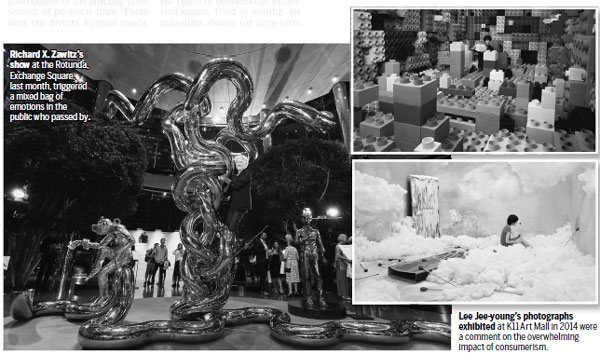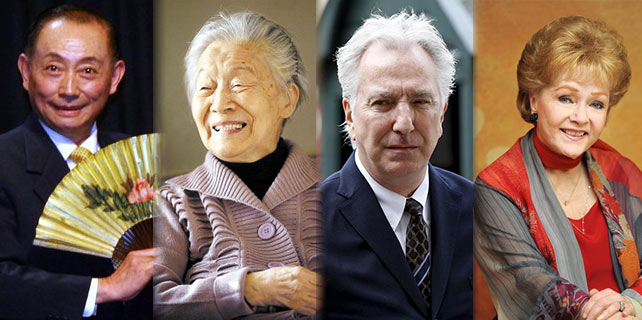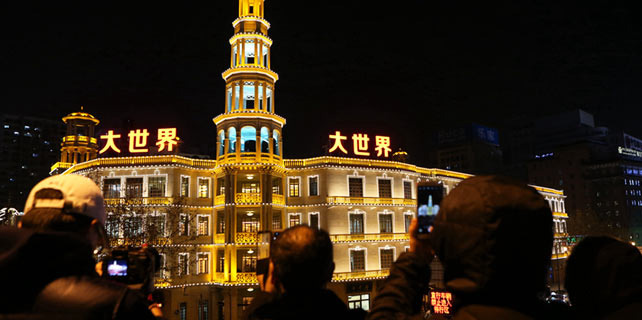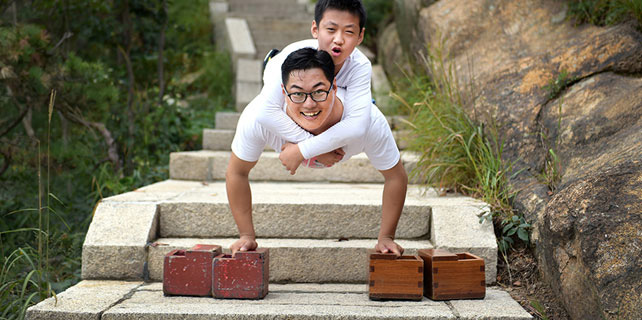Dining at the deli? Check out the Dali
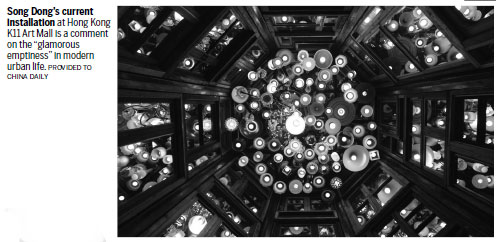
The trend of hosting art shows in privately owned spaces with public access is catching on in HK. Is exhibiting in malls the future in a city where galleries are struggling to cope with depleting footfalls? Chitralekha Basu reports.
Last April it was the giant balloons. This month it is mirrors and glass. Last time it was a 17.5-meter high installation by the architect James Shen, shooting up skyward from the base of K11 Atrium at Tsim Sha Tsui, reflecting and transmogrifying the never-ending stream of shoppers riding the escalators on its golden PVC coating. This time it is all about interiority.
Shen's gleaming cylinders and spheres have given way to an octagonal tower made of recycled window panes and mirrors, created by Song Dong. The interiors of the glass capsule are awash with lights streaming down from a complicated chandelier overhead. Placed strategically, the mirrors throw infinite reflections of the light bulbs, near-obliterating the viewer standing inside, even as they accentuate and multiply the "glamorous emptiness" within.
These two works of art, mounted in K11 Atrium within a few months of each other, explore how our perceptions of in and out might change without warning. In a way they also serve as a metaphor for privately owned public spaces, such as K11 is. Hong Kong's only "art mall" was founded with a view to making art and commerce a simultaneous experience. Visitors to K11 are expected "to appreciate art while shopping".
When a primarily profit-driven, corporate-managed property gives up part of its space to exhibit art for free, the gesture is both radical and beautifully imaginative, much the same way as Shen's giant balloon and Song's bottomless glass "well" are in the way they resist the idea of the outside-inside binary as being absolute and irrefutable.
Happily, K11 is not the only commercial enterprise in Hong Kong to put art under the same roof as retail trade. Hongkong Land hosts art shows periodically in its Rotunda at the Exchange Square and Landmark Atrium, where museum-worthy pieces by classic Western master painters, Peter Paul Rubens and Pierre-Auguste Renoir were on show alongside works by heavyweights of Chinese contemporary art, Luis Chan and Chu Teh-chun, in March. In July Pacific Place held an exhibition of Hong Kong landscapes by city artists to raise funds for a charity.
The great leveler
The day when a Zhang Xiaogang or a Liu Wei competes with Gucci bags and Louboutin heels for audience attention from the same store window may not be that far away. The sculptor Richard X. Zawitz, whose show Civilization and the Monkey concluded last month at the Rotunda in Exchange Square at Central, probably won't mind such an eventuality. In March, Zawitz's shiny, idiosyncratic metallic loops which playfully imitate the human form were part of a display showcasing pouch bags by JW Anderson at Colette in Paris. The Zen-inspired "tangles", which is Zawitz's trademark style, were replicated in the design of the bag handles.
Zawitz seems unfazed by the fact that many in the audience came to check out the fashion accessory and got to see his sculptures by default.
"What I like about exhibiting in malls is that there're a lot of accidental discoveries by people perhaps less inclined to art," says Zawitz. "Here you are reaching people who never go to museums, reaching a broader audience, bringing creativity to them."
He fondly recalls school children trooping down to his last show at the Exchange Square and how they made sketches of his sculptures, some of them scribbling "I love you, Richard" notes on the drawings. There was also a gentleman who walked up to the centerpiece, Zawitz's abstract rendition of a tree. "He started praying to the tree, to the invisible energy it seemed to disseminate," says Zawitz, still quite overwhelmed by the power of his own creation.
It also felt like a vindication of his artistic goals. "I want my audience to engage with my art, look at it, feel it smell it. I very much create art hoping they would evoke passion in people and inspire."
The Rotunda seemed like a perfect fit, not only because "its 30-meter diameter and the amazing dome which reflects the positive energy from around the environment" matched Zawitz's Zen-inspired sculptures in spirit, but also because of the amazing cross section of people it drew. There were bus drivers, Filipino maids, bank executives in business suits and high-profile art collectors.
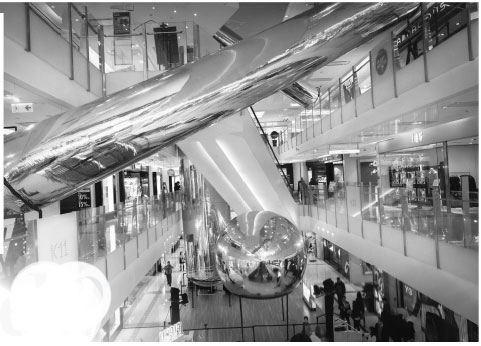
Piggybacking on luxury goods
By hosting art shows in its various open-access private properties all the year round Hongkong Land continues to play a significant role in democratizing high culture. However, says Stefan Al, who teaches urban design at the University of Pennsylvania and edited Mall City: Hong Kong's Dreamworlds of Consumption (HKU Press), the trend of "making elite art more accessible" is also "a sign of art being increasing commercialized". "It's a reflection of shrinking public budget for art and also of people's growing taste for high-end products," he adds.
The existence of K11, founded with a view to marrying shopping with art appreciation, says Al, is "especially symptomatic in Hong Kong where culture has been so much underfunded and developing platforms to showcase art is so much more expensive".
It's almost as if K11 materialized because of a gap created in the realm of conventional exhibition spaces. Tired of waiting for museums closed for long-term renovation work to reopen even as others take longer than anticipated to build, audiences are open to exploring alternative venues to see art. Malls seem like a natural choice in Hong Kong where people like the idea of getting more value for the money spent. Art resonates better with the affluent city-dweller when presented as part of a composite consumer experience, with dining, shopping and an afternoon at the spa thrown into the package.
Expectedly, not everybody is happy to see art piggybacking on Luis Vuitton bags, especially when the two are thrown together arbitrarily. Critics of the consumerist impulse to appropriate art, says Al, "call it co-op art, referring to art placed in sites - malls, corporate office spaces and public plazas - with which they do not have a relationship." Al's personal view, however, is that "if it's done well there is nothing wrong with having art in a mall. It provides opportunity for the artist to display and finance his work. It also is an opportunity for the public to see art."
At a time when gallery owners complain about spiraling rents and depleting footfalls, "shopping malls can make for a great, at least interim, solution to bring art to as many people as possible", says Lee Ho-yin, director of architectural conservation programs at the University of Hong Kong. Even architecturally speaking, malls make for sensible, user-friendly choices, he says.
"Modern high-end shopping malls have a huge atrium space with the flexibility of displaying art of different sizes, hung from the ceiling, free-standing on the ground or displayed on the wall," explains Lee. "Also these are air-conditioned, comfortable for the visitor, have good security. Climate control guarantees a degree of protection against wear and tear and humidity."
But is there a chance the juxtaposition of art and merchandize might deflect attention towards the flashier one of the two? Could malls be the right space for a serious connoisseur of art?
Lee doesn't quite see a conflict of interest as "ultimately it is about drawing people to the shop fronts". And neither does he anticipate malls turning into a gallery for mediocre art by pandering to popular tastes. "Commercial enterprises are profit-oriented. And to be able to make money out of a project, commercial players would want to bring in the very best," says Lee. "Shopping and accessing art could be very compatible."
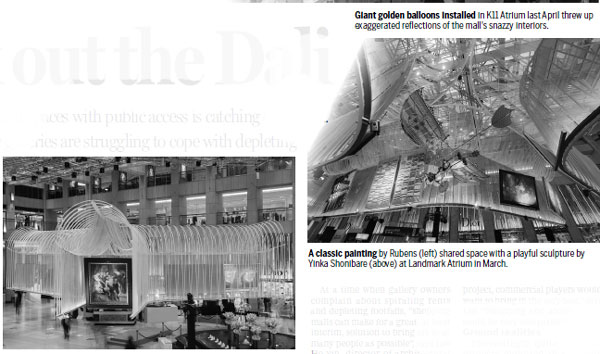
Ground realities
Interestingly, quite a few art projects mounted in K11 were a tongue-in-cheek comment on the idea of consumerism and its trappings. One of the most striking examples of using elements from pop art and kitsch to subversive effect was a series of photographs by the South Korean-born artist, Lee Jee-young, shown at K11 in 2014. Matchboxes, dices, Lego blocks and other tokens of a consumerist culture were magnified and photographed against closeted, distorted psychedelic backgrounds, showing the lone woman figure as cowering in their menacing presence. In one of the 18 images she is seen drowning in a vortex of hand-painted Chinese fans.
The series was a dig at the way the goods of desire often take up more space in people's lives than they had bargained for. Like Shen's balloon sculpture and Song's monument of mirrors, Lee tweaked elements borrowed from a consumerist culture and had the show in a space where consumerism thrives to underscore the irony.
"Having pop art exhibited in a mall is sort of art coming full circle," says Al.
Zawitz and Lee won't rule out malls devoting more spaces to art in the future, taking a share of the market that has conventionally belonged to art galleries and museums. Zawitz says such a trend would be particularly welcome in a city like Hong Kong since "there are hardly any galleries at the street level here because it's so expensive". Malls have a distinct advantage over galleries tucked away in the higher floors of industrial buildings, usually visited only by the invited aficionados on opening nights, he says, with less chances of attracting a potentially interested passer-by.
Al, however, wouldn't want to see the galleries in Central and Sheung Wan go, or, at any rate, lose their influence in the city's art ecosystem if indeed malls ate into a chunk of their business. "Walking from gallery to gallery is an outdoor experience, whereas malls are introverted, insulated from the city."
He, for one, would miss the vibe an art gallery inspires in the street on which it is located if more of them shut shop and the art they dealt in ended up on a shopping mall display window.
Contact the writer at basu@chinadailyhk.com
